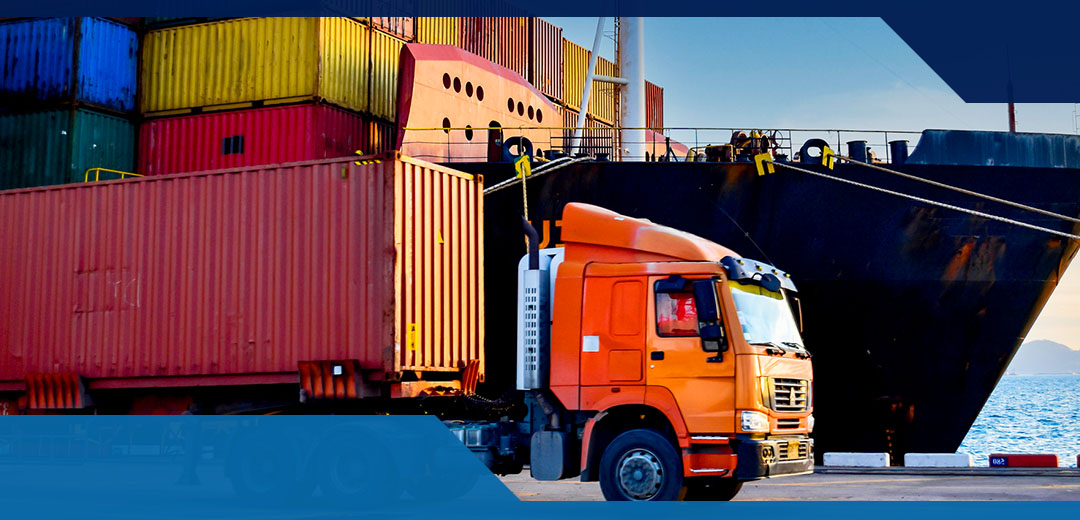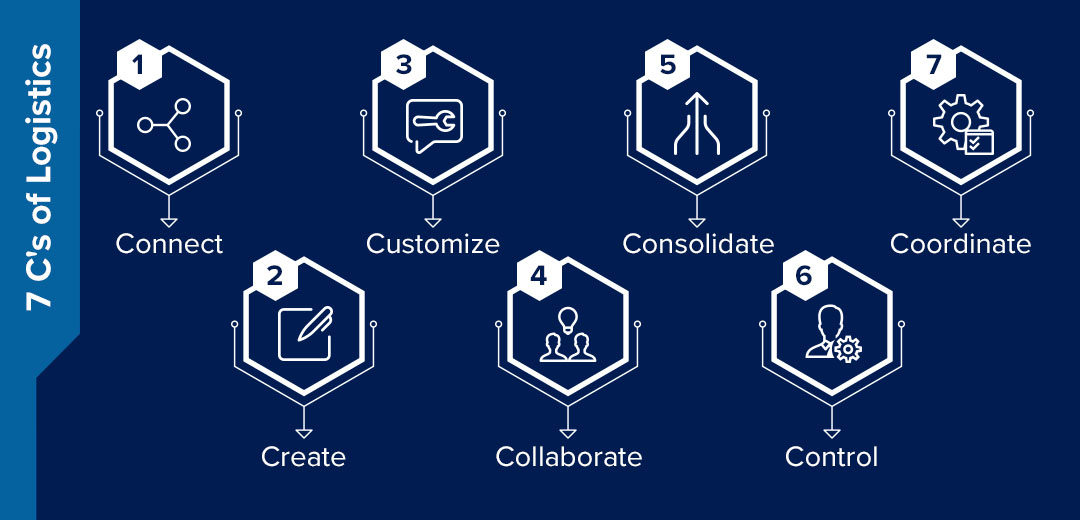
Logistics is the backbone of your supply chain management. Getting everything where it needs to be while staying on schedule is critical for boosting your efficiency. Without a focus on logistics, your supply chain can quickly fall apart.
Logistics and supply chain managers understand how important organization and strategy are to their business. Effective logistics involves detailed strategy, seamless execution and rapid adaptability. Achieving these qualities means creating a solid framework. Once you have that foundation, you can streamline logistics and support company success. The 7 C’s of supply chain management are a type of framework used to address your logistics challenges. Understanding them can help you stay competitive in the logistics industry while optimizing your processes. The 7 C’s of logistics include:
- Connect
- Create
- Customize
- Collaborate
- Consolidate
- Control
- Coordinate

1. Connect
Connecting is everything in logistics. You need to connect with stakeholders, connect suppliers to manufacturers, and connect customers with solutions. “Connect” also applies to your supply chain itself. How are you connecting suppliers and carriers? How is the product reaching its destination? The better your partnerships, customer relations and transportation, the better your logistics.
Technology is a great way to boost your connect strategy. Use tools like transportation management systems (TMS) to get real-time updates. You’ll immediately see delays, improve transparency and keep all your stakeholders in the loop. These systems track all your essential information. You can update stakeholders and respond to challenges as soon as they pop up, reducing delays and ensuring everyone stays connected. You can also use chatbots to make customer connections faster, resolve tickets more effectively, and create a better-connected system overall.
Connection isn’t just about technology — it’s also about building strong relationships. You need reliable partners and good standing to expand your reach. Make sure to invest in strong connections to reduce disruptions and support trust. When you can rely on your network, you can easily keep pace with the global market.
2. Create
Creating efficient logistics systems involves developing the right strategies. You need a tailored approach to meet your organization’s goals. You might create by designing optimal routes or by using analytics to forecast demand. The better you can innovate and adapt to logistics challenges, the smoother your operation.
Creation also extends to your value-added services. You might consider offering last-mile delivery solutions or greener strategies. These creative solutions add an extra benefit to working with your operation, making you more competitive. The more you create and streamline, the more productive, cost-effective and efficient your logistics team becomes.
3. Customize
The third C is all about meeting specific needs. Logistics isn’t a one-size-fits-all industry — it’s about tailoring your operation to client and industry needs. Some customers might prioritize speed, while others want more sustainability in their operations. Do you need to tweak one service to meet cost demands? Do your customers need more flexible options? Tailoring your delivery, packaging and compliance options can improve customer satisfaction and retention.
Customization is critical for logistics professionals. When you understand client goals, you can fit your solutions to their needs. Personalize your offerings and support to make better long-term partnerships.
4. Collaborate
While connecting covered every aspect of logistics, collaboration is a slightly different area. You need to connect to collaborate, but this C is about achieving shared goals. Focusing on collaboration lets you share resources, reduce risks and innovate processes. Logistics managers can collaborate with third parties to develop solutions for specific challenges and meet unique needs. When you focus on strategic collaboration, you bring new ideas and better efficiency to your operation.
Effective collaboration requires trust, communication and mutual benefits. Cloud-based platforms make it easy to share information and eliminate inefficiencies. Teams work together to approach problems, creating strategies that benefit all parties. Better collaboration lifts up the entire network.
5. Consolidate
Consolidation is about combining your resources to improve efficiency and costs. Juggling many separate shipments and resources spreads you thin and increases your supply costs. Sending four separate orders to the same general area means four times as much fuel, labor and time costs. Consolidating your freight reduces transportation costs, empty trucks and carbon use.
You should also consolidate other logistics areas outside of freight. Consider consolidating warehouse organization, centralizing your data systems and merging supplier contracts. Logistics managers can use consolidation to eliminate redundancies and make resource use more effective. You’ll see lower expenses and faster delivery times when you cut the waste from your supply chain management.
6. Control
Control means maintaining oversight over the entire logistics process. Supply chain bottlenecks and geographic challenges can happen at any moment. Overcoming these challenges involves an effective control system to prevent issues from affecting your operation. Logistics managers should use real-time tracking, inventory management and key performance indicators (KPIs) to keep everything on track.
Improving your control systems and strategies can create more effective supply chain management. Tight control reduces risks, maintains regulatory compliance and prevents losses. For example, the better your inventory count, the fewer shortages or overstocking issues you’ll see. Better monitoring leads to on-time deliveries and faster adaptability. Keep everything running smoothly with effective control.
7. Coordinate
Finally, you need to coordinate for successful supply chain management. Production schedules need to line up with transportation times, while suppliers and retailers should be on the same page. Focusing on coordination creates a seamless flow and reduces inefficiencies. Technology and communication should come together to support your coordination efforts. Without the right tools, you could miss opportunities, experience more delays and affect customer satisfaction.
Supporting all the essential coordination measures takes lots of resources. Consider investing in software or working with a third party to make coordinating logistics for ocean services, customer support and other essential sectors easier. With expert support and technology, you’ll make coordination easier for everyone. Prioritizing coordination ensures every link in the supply chain operates as part of the system.
Optimize Your Supply Chain With EMO Trans
Now that you understand what the 7 C’s of logistics are, it’s time to put them to work. EMO Trans is here to help you bring these strategies to life through customized global logistics solutions. We work closely with you to tailor our strategies to your needs. From seamless connections to precise coordination, we can help optimize every step of your supply chain.
Our extensive network of over 100 offices across 25 countries and over 250 partner locations ensures your cargo is managed with local expertise. We offer a global reach for all our clients, whether they’re consolidating shipments, controlling costs or collaborating with key partners. Our dedicated team will deliver solutions designed for success.
Partner with a logistics company that’s been building trust and going above and beyond for over 60 years. Request your quote today and see how EMO Trans can streamline your operations!

